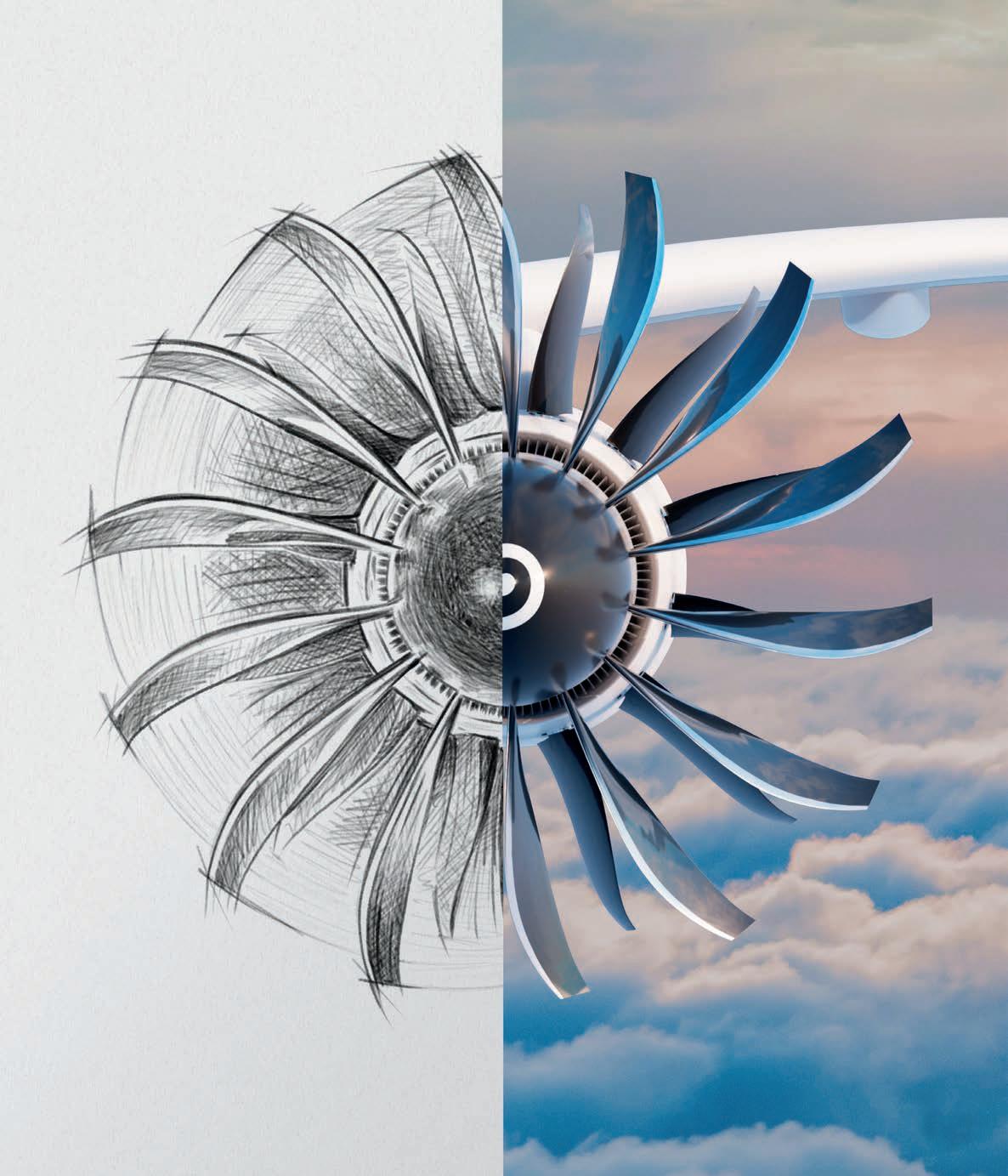DAY 4
PARIS AIRSHOW NEWS
JUNE 19, 2025
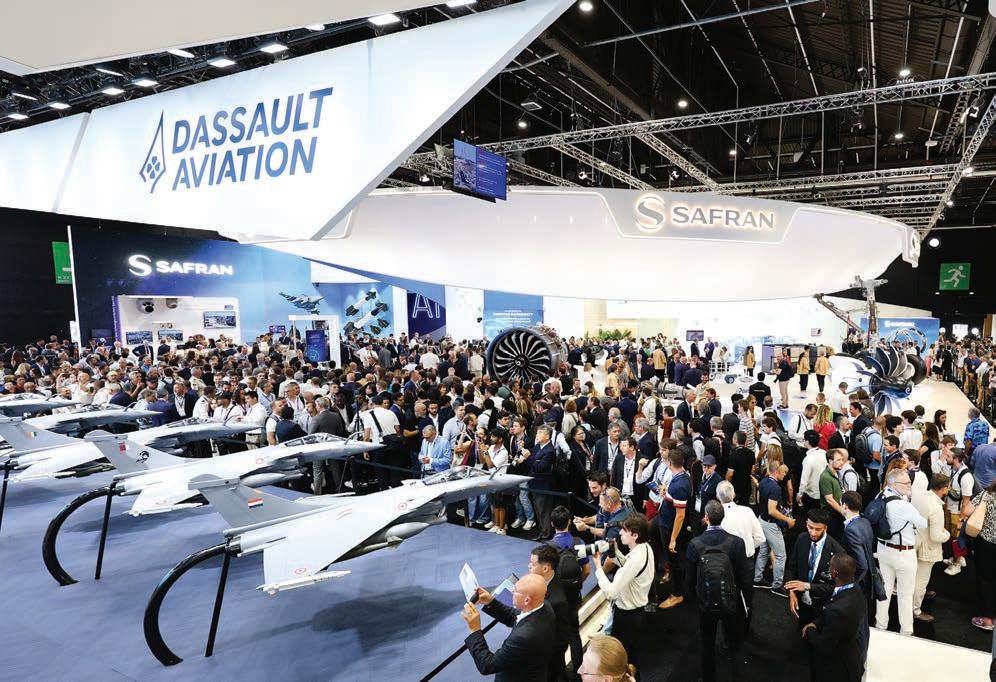
EMBRAER’S EXTRAVAGANZA IN PARIS
By Charles Alcock
SkyWest Airlines aims to bolster its position as the world’s largest operator of Embraer’s E-Jets through a $3.6 billion deal signed at the Paris Air Show yesterday. The U.S. carrier placed firm orders for 60 E175s and secured purchase rights for 50 more.
Deliveries are set to begin in 2027 to SkyWest, which operates regional connections throughout North America for carriers including Delta, United, American, and Alaska Airlines. Its fleet already includes 263 Embraer aircraft, and it has 16 more on order.
Embraer also found success in its defense business when the Lithuanian government said it had chosen the C-390
Millennium military transport aircraft. Announced yesterday afternoon, the deal—which is subject to completion of the formal acquisition process—also covers industrial cooperation terms under which Lithuanian organizations could be involved in maintenance, repair, and overhaul, as well as parts manufacturing for the twinjet.
Lithuania’s military is working to enhance its operational readiness and interoperability with other NATO members. “We have carefully studied the various types of military transport aircraft available on the market, and our assessment has clearly shown that the C-390 Millennium is the most suitable platform to meet our national legal procedures and legislation,” said Loreta Maskaliovien ė , the continues on page 22
AINONLINE . COM
AIRCRAFT
Wisk adds partners Miami and Naga, Japan, come on board as the latest early adopters for company’s eVTOL | 16
POWERPLANTS
Small jet unveiled PBS group of the Czech Republic reveals 513-pound-thrust turbine for drones and guided missiles | 10
SUSTAINABILITY
TotalEnergies paves way for SAF
Fuel producer investing in biofuel refineries in Europe as SAF mandates kick in | 12
DEFENSE
Airbus stabilizes A400M production Company will make eight of the airlifters per year through the end of this decade | 9 airshow repor ts
GET THE LATEST AIRSHOW NEWS!
French alliance plans hybrid propulsor for GA
By Charles Alcock
Daher, Safran, and Collins Aerospace are joining forces with French start-up Ascendance to develop hybrid-electric propulsion systems for general aviation. The partners announced the joint effort yesterday at the Paris Air Show, saying they will prioritize technology for sixto 10-seat aircraft.
Called TAGINE (Tentative dans l’Aviation Général d’Introduction de Nouvelles Énergies), the two-year project has financial support from France’s civil aviation authority (DGAC) and the civil aviation research council (CORAC).
TAGINE will build on work conducted for the recently concluded EcoPulse hybridelectric technology demonstrator, a collaboration between Daher, Safran, and Airbus. The TAGINE program partners pledged to present key conclusions and milestones at the 2027 Paris Air Show.
Daher will provide its multirole Kodiak 900 turboprop as a use-case platform for the hybrid-electric architectures being evaluated. The partners believe that some 27,000 existing aircraft in this category could be suitable for conversion.
“This could be suitable for different aircraft manufacturers, and we decided we could not work alone on this,” Eric Seinruirer, v-p of technology and future programs at Safran Helicopter Engines, told AIN . “It’s about understanding the best compromise [in terms of propulsion options] between the aircraft and the mission. It’s always a balance.”
Safran Helicopters and Safran Tech are studying the feasibility of a hybrid propulsion system based on a new turbine engine and an electric motor. The system would combine electric and thermal power to drive the propeller.
Collins Aerospace is leading the aeroacoustic optimization studies for the propeller and will be involved in the integration of the propulsion system and propeller as well. The company is also designing a fully electric pitch change system for propellers used in general aviation aircraft in the same class as the Kodiak.
Ascendance, which is developing a hybrid-electric VTOL aircraft called the Atea, will allow the project partners to use its hybrid operating system for energy optimization. It is also responsible for identifying the battery energy requirements. z
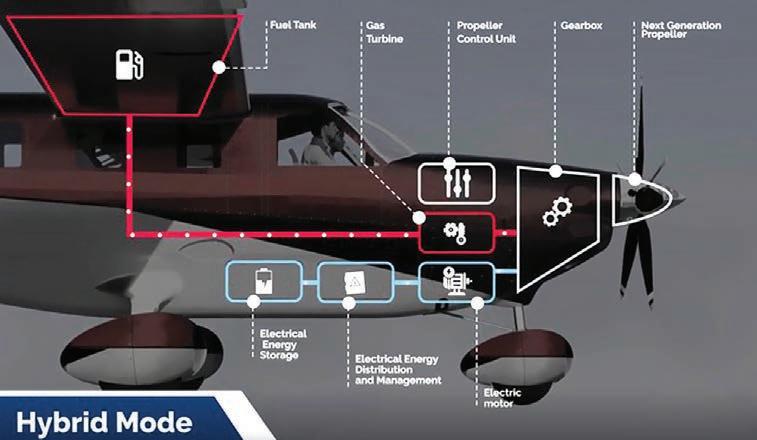
France contracts Daher and Thales to develop MALE drone prototype
France’s DGA defense procurement agency has selected Daher and Thales as the main partners in a consortium to develop a medium-altitude long endurance (MALE) drone demonstrator. As part of e orts to expedite the availability of sovereign French capability by 2030, the partners have committed to conducting a remotely-piloted flight demonstration and providing a full technical specification by the end of 2026.
Daher will provide an as-yet unspecified aircraft platform to be combined with Thales’ ground station, ground-to-air data link, and flight control system. DGA said the forthcoming MALE platform is intended to complement France’s current drone capability.
At a Paris Air Show media briefing yesterday, Daher said the requirement is to use a “plug-and-fly” solution based on an aircraft already certified under EASA’s CS23 general aviation rules. The company indicated that it may be able to accelerate the program and achieve a flight demonstration in just six months.
The new MALE platform will be certified on an ITAR-free basis, meaning that the U.S. government will now have control over the technology’s use. It would be suitable for either piloted or uncrewed operations.
“With more than 30 years of experience with our TBM and Kodiak products, Daher is now a key strategic player in the development and delivery of MALE drones,” said Nicolas Chabbert, senior v-p of Daher’s aircraft division. “We provide a sovereign, mature, and agile response to today’s strategic challenges.”
In 2024, military activities accounted for 15.5% of Daher’s revenues, generating €300 million ($345 million). C.A.
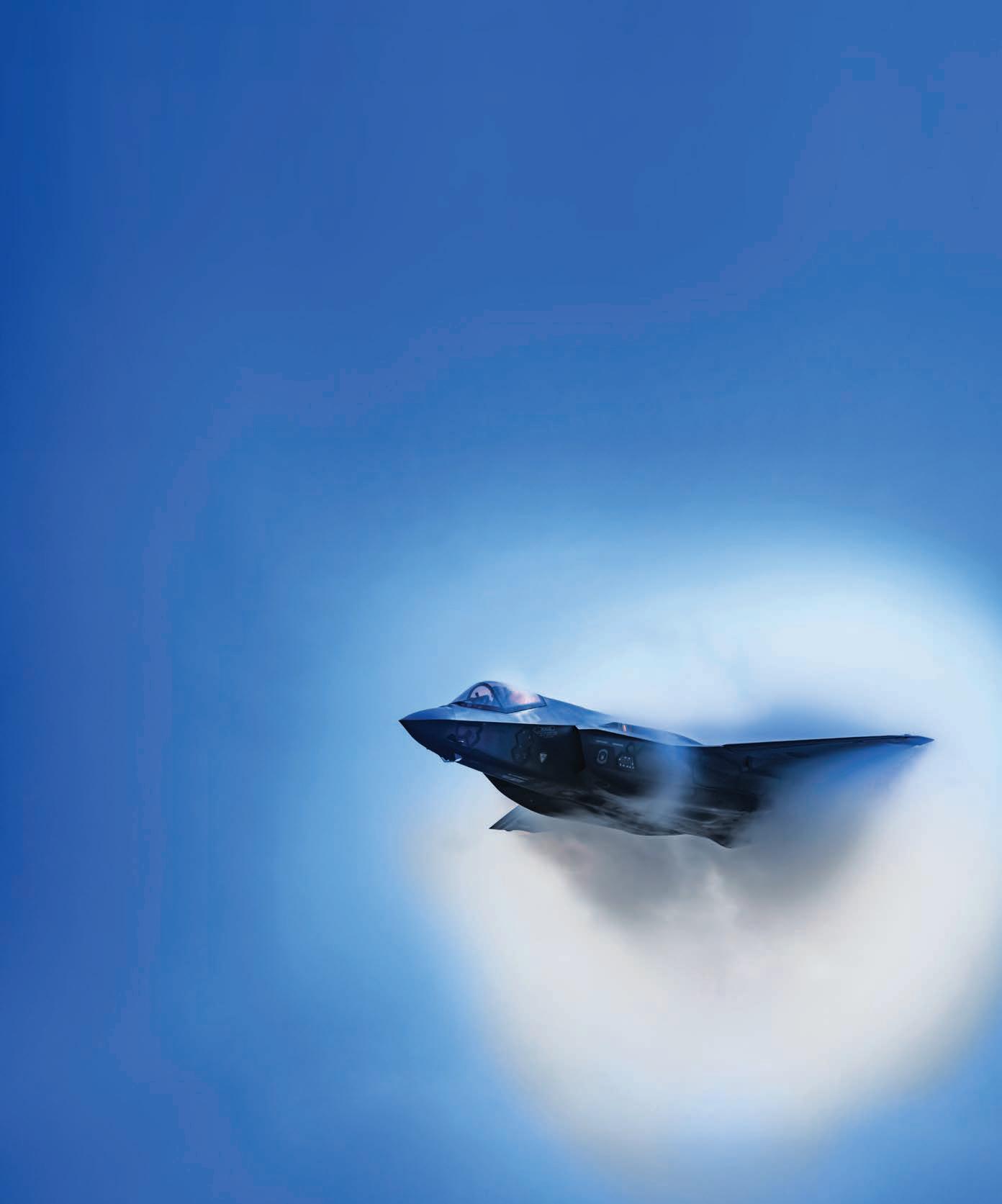
CONNECTING PROTECTING WORLD OUR AND
With three market-leading businesses, world-class operations and investments in research and development, we ofer capabilities no one else can. Together, our global team pushes the boundaries of known science—and fnds new ways to connect and protect our world.
Visit RTX at Pavilion C2
Starlux ordered 10 Airbus A350-1000s.
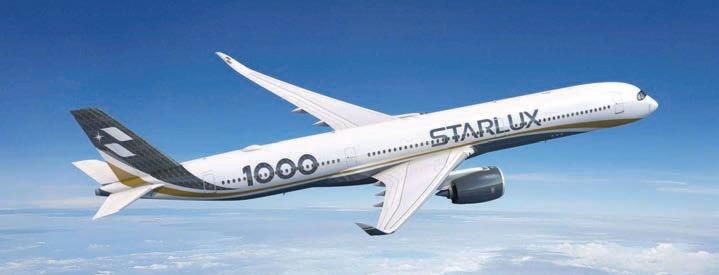
Airbus widebody, helo order books soar
Airbus has continued with a steady flow of order announcements during the Paris Air Show, announcing four more deals combined for up to 26 aircraft and helicopters yesterday. Starlux Airlines of Taiwan placed a firm order for 10
more A350-1000 widebodies, joining the Taiwanese carrier’s all-Airbus fleet of A350-900, A330neo, and A321neo airliners. Starlux has 30 aircraft on order, including A350F freighters, in addition to the A350-1000s.
eVTOL success needs global cooperation
By Charles Alcock
American advanced air mobility pioneers are poised to lead the world in launching commercial eVTOL air services, but only if they embrace opportunities to work across borders rather than taking a parochial approach, according to industry leaders speaking at a session staged by the state of Ohio at the Paris Air Show yesterday.
In a panel discussion, senior executives from Archer Aviation, Beta Technologies, and Wisk Aero also heard that, to make the business model viable, the eVTOL industry will need to achieve unprecedented rates for both manufacturing and flight operations.
Kyle Clark, CEO of Beta, warned that the U.S. will lose its leadership position without global thinking and harmonization. He said leadership necessitates international collaboration rather than exclusivity, as aerospace has historically never been a purely domestic market.
Beta is targeting parts of the world such as Scotland and the Nordic countries for its Alia electric aircraft, which has been a star of the Paris show’s flying display this week. The aircraft are set to conduct extensive operational trials with customers in Norway and New Zealand.
Archer chief commercial officer Nikhil Goel endorsed the case for the U.S. industry to avoid an inward-looking approach. In his view,
Egyptair disclosed an order for six more A350-900s, bringing its total order tally for the type to 16. The agreement, the second Egyptair has placed for the model, comes as the airline looks to modernize its fleet and expand its network over the next five years.
These deals also included a memorandum of understanding with global logistics provider MNG Airlines for two A350F freighters. The agreement positions the A350F to become a key part of MNG’s future fleet as it expands its trade lanes in Europe, the Middle East, Asia, and North America. The aircraft will support its scheduled and charter operations.
On the helicopter side, Norwegian Air Ambulance signed a frame contract for up to eight Airbus H145s. That contract includes a firm order for two. K.L.
the best path to success is to export American talent, engineering, and aircraft globally to markets such as Southeast Asia, Africa, East Asia, and the Middle East. The company is preparing to deliver examples of its Midnight eVTOL model to the UAE, where partners will conduct trial operations in Abu Dhabi.
According to Clark, eVTOL operators will want to target up to 10 flights per aircraft each day to exploit the efficiency of electric propulsion. His counterpart at Joby Aviation, JoeBen Bevirt, said that manufacturers should aspire to achieving the sort of rapid-scale production not seen in the industry since just after World War II, with automotive manufacturers like his main backer Toyota playing a leading role in achieving this goal. z
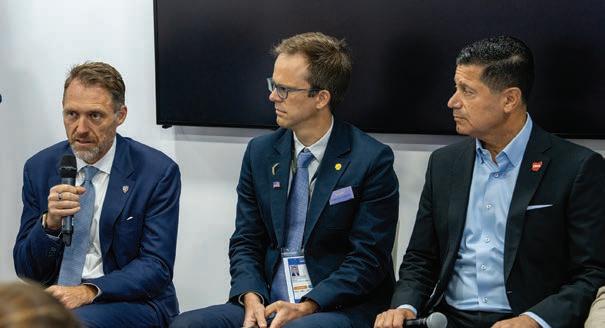
Aviation founder and CEO JoeBen Bevirt speaks during a panel discussion on advanced air mobility at the Paris Air Show yesterday.
JSX adds ATR 42-600s, Air Tahiti takes HighLine
By Kerry Lynch
After reporting the strongest post-Covid first half with orders for 30 regional turboprops, ATR is expanding its market with a placement of the first ATR 42s with U.S. carrier JSX and selection of the HighLine all-business-class cabin by Air Tahiti for its ATR 72s. These came in addition to last week’s 19-aircraft sale to Taiwanese carrier UNI Air.
JSX is leasing a pair of ATR 42-600s that will enter service later this year. The two aircraft, intended to expand its reach into underserved airports across the U.S., will be configured for 30 seats, keeping within its operational parameters as an FAA Part 135 carrier. Offering a per-seat model under U.S. Department of Transportation Part 380 economic authority, JSX operates a fleet of ERJ-135s configured with 30 seats from FBOs in the U.S.
The carrier also signed a letter of intent for up to 25 either HighLine-fitted ATR 42-600s or ATR 72-600s with 30 seats. ATR noted the partnership marks its foray into the U.S. charter market.
ATR chief commercial officer Alexis Vidal added that the sale is in line with its goal to help open up new routes. He also pointed out that the U.S. has lost up to 800 routes in the past couple of decades as regional jets pulled back from more costly operations.
“The ATR-600 series will bring over 1,000 new airports into reach for JSX, expanding access to reliable public charter flights across the great U.S.,” added JSX CEO Alex Wilcox. “Many of these airports were, until now, reserved only for those who had the means to fly private.”
Meanwhile, long-time customer Air Tahiti has opted for ATR’s new HighLine business class cabin interior for one of its four previously ordered ATR 72-600s. Configured with 26 individual business class seats with a oneby-one configuration, the HighLine version will help Air Tahiti launch a VIP service, initially to the islands of Bora Bora and Raiatea.
Designed by Geven for ATR, the Eterea seats will have a width of 21.6 inches, a pitch of 39 inches, and a seven-inch-deep recline. The interior also includes a personal side console, dedicated stowage, USB-A and -C ports, and direct aisle access and window views.
Speaking to reporters on Wednesday at the Paris Air Show, Air Tahiti CEO Edouard Wong Fat noted the carrier’s 40-year relationship with ATR and said it has enabled it to provide critical service linking distant islands, cutting travel
As they announced their latest customer activity, company executives also provided an update on their sales so far this year, detailing that it had already recorded 30 commitments in the first half, including the 19 ATR 72-600s ordered from UNI Air and 11 ATR 72-600s from two undisclosed customers. This pushes the lifetime orderbook to 1,900 aircraft sold.
ATR CEO Nathalie Tarnaud Laud noted the strong start to the year and added, “We have a very strong pipeline,” showing promise for the rest of the year. The 30 coming into midyear compares with 56 for all of 2024, 40 in 2023, and 26 in 2022. She added that plans call for slowly ramping up production, up to 60 aircraft over the next four years, balancing that against supply chain availability.
“This year is also a year of preparing for
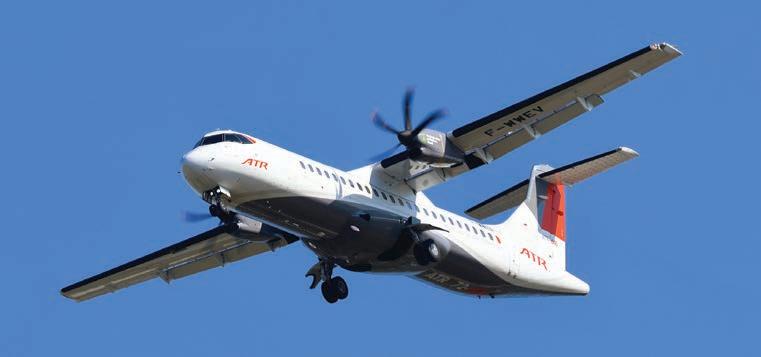
time from days to hours. Its services have been “very traditional,” he added, saying the airline felt something was missing in the value chain.
HighLine will enable it to offer a business-class experience on domestic routes, including with private VIP terminals, he added.
In the days leading up to the Paris Air Show, ATR had secured the UNI Air order for nineteen 72-600s, with purchase rights for three more. This marked the largest order ATR has received since 2017 and is the second from UNI Air since 2011, when it bought 10 ATR 72-600s at the time.
The Taiwanese carrier will take delivery of the aircraft between 2027 and 2032, with 14 of the 19 planned to be replacements for existing ATR 72-600s and the remainder for fleet expansion. The move will modernize the UNI Air fleet with next-generation Pratt & Whitney Canada PW127XT engines and an updated cabin.
the future,” Tarnaud Laud said. “We want to ramp up. That’s very clear, and that’s why we are putting a lot of effort into improving our processes, improving the way we work with our suppliers, to start [the ramp up] in 2026.”
Feeding this drive is ATR’s newly released 20-year turboprop forecast for up to 2,100 aircraft deliveries. ATR anticipates that the first 10 years will primarily focus on aircraft replacement, and the second will be oriented toward growth with fleet and route expansion. In all, ATR anticipates the turboprop fleet to number 2,585, up from the current 1,650.
This latest forecast scaled back from ATR’s 2022 projection for 2,450 new aircraft over the subsequent 20 years, but Vidal noted that the downsized outlook reflected contraction from other turboprop manufacturers rather than its own market.

Boeing Defense grows business in Europe
By David Donald
Boeing Defense Space & Security (BDS) has been an important player in European defense for decades, and its business in the region continues to grow at a considerable rate as the continent comes to terms with harsh geopolitical realities, highlighted by conflicts in Ukraine and the Middle East. The division now has more than 8,000 employees across 12 European nations supporting 25 armed forces.
Overall, Boeing spends billions of dollars in Europe annually across military and commercial sectors, mostly in the supply chain. Notable markets are in France, where Boeing spends €1.2 billion, Germany (€1.1 billion), Italy (€800 million), and the UK (£15 billion over the last 10 years). The company also performs an increasing amount of sustainment work.
BDS plays a key role in developing local industry capability in countries such as Poland, which is undergoing a large uplift of modern aircraft into its air force. Polish company PGZ is gearing up to service the fleet of 96 AH-64E Apaches that are soon to be delivered to the country’s air force. In Ukraine, Boeing has teamed with Antonov to rebuild the local aerospace industry, with a small UAV now under development.
Naturally, BDS is pursuing opportunities to sell its main product lines into the European market. The T-7 Red Hawk advanced trainer, P-8 Poseidon maritime patroller, E-7 Wedgetail AEW aircraft, KC-46 Pegasus tanker, and the AH-64 Apache and CH-47 Chinook helicopters are all vying for further sales around the continent.
E-7 as AWACS Replacement
In France, for instance, the E-7 is being pitched to replace the air force’s aging E-3F AWACS aircraft, and the P-8 waits in the wings if the preferred Airbus-based solution for an Atlantique maritime patroller replacement stumbles.
Meanwhile, the E-7 has already been
selected to replace the E-3s of the multinational NATO fleet. Denmark and Italy could also buy the P-8, with the Danes looking to increase their Arctic security capability. Norway is studying an increase of its P-8 fleet while Italy may also look to buy KC-46 tankers to augment or supplant its current KC-767s. Poland continues to expand its air force and has stated desires for heavy-lift helicopters and tankers. There is also a requirement for 32 more heavy fighters, for which Boeing’s F-15EX Eagle II is a prime candidate.
Germany is buying 60 CH-47 helicopters for delivery from 2027 and is to receive its first P-8 in September. There is a looming training requirement for which the T-7 is a candidate, and it is possible that the army may adopt the AH-64 attack helicopter.
The UK is also facing the need for advanced training as the Hawk fleet nears the end of its useful life. It is discussing the expansion of its E-7 fleet beyond the current three aircraft.
Both Germany and the UK are in the market for a collaborative combat aircraft (CCA) to support Typhoons and F-35s, and Boeing is pitching the MQ-28 Ghost Bat developed by Boeing Australia. The type is the most advanced CCA in terms of its development
status and has recently demonstrated the ability to be controlled from an Australian E-7. Two live MQ-28s and a virtual digital CCA were recently flown in a combined operation. Boeing sees significant opportunities for the MQ-28 elsewhere in Europe and has suggested that it could find local partners to build the air vehicle in the customer nation.
Other Programs
Boeing’s other main current uncrewed program is the MQ-25 Stingray, of which the first seven are now in final assembly for delivery to the U.S. Navy for carrier-borne tanker duty. First flight is expected by year-end. While the company is focusing on delivering the capability to the U.S. Navy, it could be of interest to land-based operators. Thus, it is studying a land variant with a boom refueling installation.
Partnership with local industry is a key element of BDS’s strategy in Europe, covering supply chain, sustainment, and co-development activities. An example of the latter is the partnership with Saab on the T-7, which is building and holding design authority for the aft fuselage subassembly.
A sizeable portion of BDS’s research and development is now focused on the U.S. Air Force’s F-47 Next Generation Air Dominance fighter. Little detail can be said about NGAD at the time of writing, but BDS’s interim president, CEO, and COO Steve Parker noted that a related X-plane had flown “hundreds of times” since 2019. z
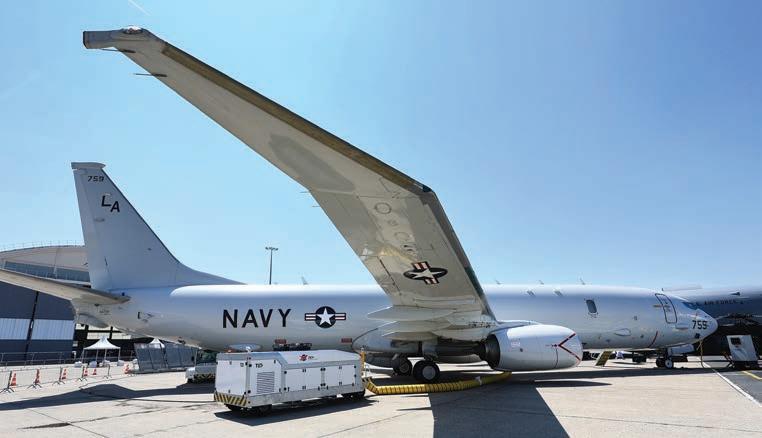
Norway is mulling adding more Boeing P-8 maritime aircraft.

Airbus stabilizes A400M production
By David Donald
Airbus and NATO procurement agency OCCAR have signed an agreement that will see production of the A400M airlifter secured for the foreseeable future, as well as the joint development of additional capabilities and efforts to lower operating costs. Until 2029, production will be stabilized at an optimum rate of eight aircraft per year, achieved by bringing forward build slots for four aircraft for France and three for Spain.
Meanwhile, Airbus continues to develop the A400M and add new capabilities, including firefighting and for stando ff jamming. It is also being proposed as a mothership for remote carriers of varying sizes. In this role, the A400M could release swarms of uncrewed air systems and then control them from onboard.
At a more prosaic level, the A400M is likely to get a payload increase from 37 tonnes to 40 tonnes with only a limited technical upgrade required.
Jean-Brice Dumont, the head of air power for Airbus Defence and Space, noted that discussions regarding the A400M are ongoing with the United Arab Emirates, among other potential customers.
Airbus’ other military large aircraft program is progressing well, with the first A330neo-based MRTT+ multirole tanker-transport now in production. Due for delivery to an undisclosed launch customer, the first neo tanker-transport is scheduled to be delivered by the end of 2028. The type is attracting increasing interest, especially as the geopolitical situation is increasing the need for agile combat employment through the rapid deployment of combat aircraft.
Nordic countries are interested in joining the pooled NATO tanker operation, which would require additional aircraft to the 10 already acquired. Airbus is delivering four to five MRTTs per year from its Madrid Getafe plant, which may need to be enlarged if more orders come in. An additional site could also be considered.
Another field in which Airbus is active is uncrewed air vehicles (UAVs). The flagship project is the Eurodrone medium-altitude long-endurance (MALE) drone under development by Germany, France, Italy, and Spain. There has been a delay in the critical design review of around a year, but it is due soon, with no change to the planned service entry date at the end of the decade. Both India and Japan have shown interest in joining the program as observers or possibly
Production of the Airbus A400M airlifter is set at eight per year until 2029. Airbus also continues to add capabilties to the airplane, including firefighting and standoff jamming.
even as developmen t contributors.
In the meantime, the Airbus Spain-developed SIRTAP medium MALE UAV rolled out recently and is on course for first flight by year-end. First deliveries are officially set for the first half of 2027, but Dumont noted that they could be earlier.
In the longer term, the principal program for Airbus Defence and Space is the NextGeneration Weapon System (NGWS), which forms part of the Future Combat Air System (FCAS). NGWS encompasses a crewed aircraft, the Next Generation Fighter (NGF), for which Dassault is leading development work. Airbus is leading the development of remote carriers and other elements, such as combat cloud networking.
With service planned from 2040, NGWS is currently in Phase 1b of the development process, with hardware demonstrations beginning in Phase 2. The latter will include flight trials of NGF demonstrators and remote carriers.
There has been some acrimony between Dassault and Airbus, in part regarding workshare, for which Dumont suggested a “softer, smart” agreement was needed. He commented that Airbus was completely committed to NGWS, that there was no opposition to Dassault leading NGF, and that “we have to make [FCAS] happen, but we might have to change the workshare to make it executable. “It’s two competitors poised to marry,” added Dumont. “It’s not an easy position. Today we protect our IP; tomorrow we have to share it.” z
PBS reveals little jet engine that could
By Kerry Lynch
Czech manufacturer PBS Group has unveiled the most powerful turbine powerplant in its portfolio to date: the 513-pound-thrust TJ200 jet engine. The introduction this week at the Paris Air Show follows a rigorous testing program and paves the way for initial applications, the company said.
Developed at its main production plant in Velká Biteš in the Czech Republic, the PBS TJ200 marks a “new technical concept” for the company that has a product line of motors with a tensile range of 0.4 to 1.5 kilonewtons (kN).
With a continuous thrust of 2.28 kN and a thrust of 2.7 kN for 30 seconds, the new engine brings a 50% increase in tension compared with PBS’s TJ150. This opens the door for a much wider range of possibilities for use in defense systems and commercial uncrewed aircraft where high performance is required. Applications include drones, guided missiles, and target practice.
The engine is equipped with a full authority digital engine control, or Fadec, as well as a brushless DC starter-generator. Its seawater-resistant design is fuel-lubricated for maximum operating efficiency.
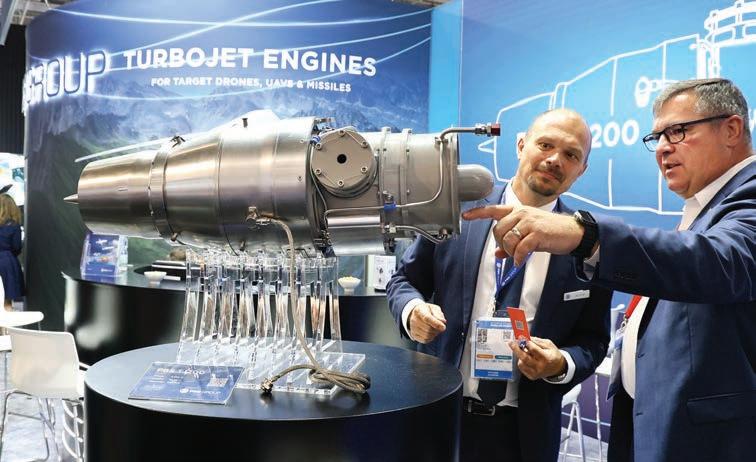
The 513-pound-thrust TJ200 is now the flagship jet engine at Czech company PBS Group. Applications for the powerplant include drones and guided missiles.
“We are receiving preliminary orders from major manufacturers from different parts of the world,” said PBS Group CEO Petr Kádner. “The new engine is designed to meet current customer requirements, and we believe that the PBS TJ200 will soon become the flagship product of our portfolio.”
PBS is working with Ukrainian company Ivchenko Progress to develop the AI-PBS-350 jet engine. Announced last year at the Farnborough International Airshow, the AI-PBS-350 will aim for applications in cruise missiles and larger unmanned aerial vehicles. z
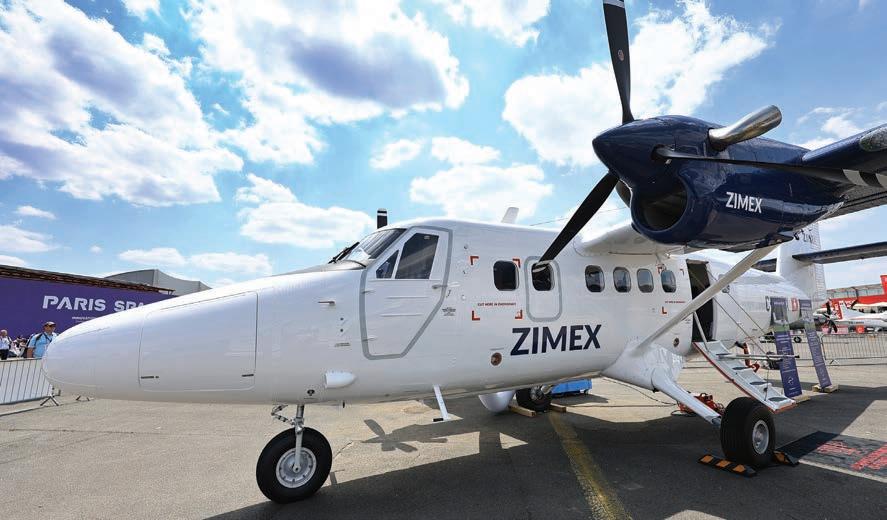
Twin Otter
Classic 300-G takes a bow
De Havilland of Canada’s Twin Otter Classic 300-G is making its international airshow debut here this week at Paris Le Bourget. The new variant has Garmin G1000 avionics and a redesigned cabin that is not only more comfortable but is also lighter in weight than previous interiors.
ATR, P&WC partner on next-gen turboprops
By Charles Alcock
Pratt & Whitney Canada (P&WC) and ATR have agreed to work together to develop propulsion systems for a new generation of turboprop regional airliners. Under a partnership announced on Monday at the Paris Air Show, the companies plan to focus on increasing the efficiency, performance, and operating economics of engines that could power aircraft such as ATR’s Evo concept.
The current ATR42 and ATR72 commuters

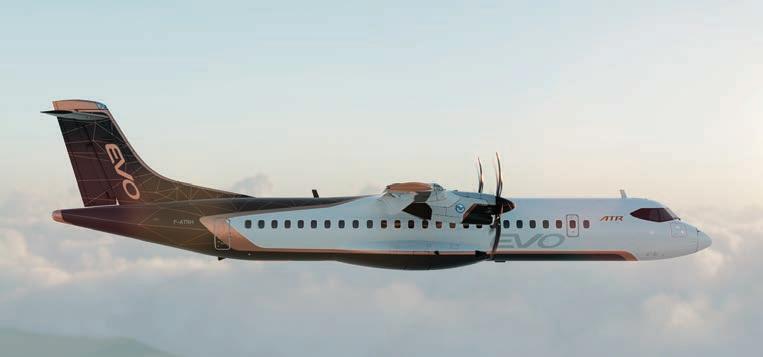
are fitted with PW127XT turboprops. ATR and P&WC said their engineers will focus on innovations. For example, they aim to increase thermal efficiency to reduce fuel burn; apply advanced materials to improve engine durability and reliability, reducing maintenance costs; and refine aircraft aerodynamics by optimizing engine, nacelle, and aircraft integration.
In addition, P&WC and ATR will explore
Pratt & Whitney Canada and ATR are exploring hybrid-electric options for the ATR Evo concept.
This digital newsletter, delivered directly to your inbox Monday through Friday, is the most trusted source for daily business aviation news. To subscribe: - Scan the QR code - Visit ainonline.com/subscribe - Email subscriptions@ainonline.com
options for hybrid-electric propulsion as part of a feasibility study for the ATR Evo models. The European airframer announced the Evo project in 2022, and at the time indicated it aimed to bring the aircraft into service in 2030.
Today, 1,300 ATR aircraft are powered by P&WC engines, including the most current PW127XT-M turboprop. P&WC, which is part of the RTX group, is celebrating its centenary this year. z


TotalEnergies’ refinery in Grandpuits, France will be a zero-crude facility.
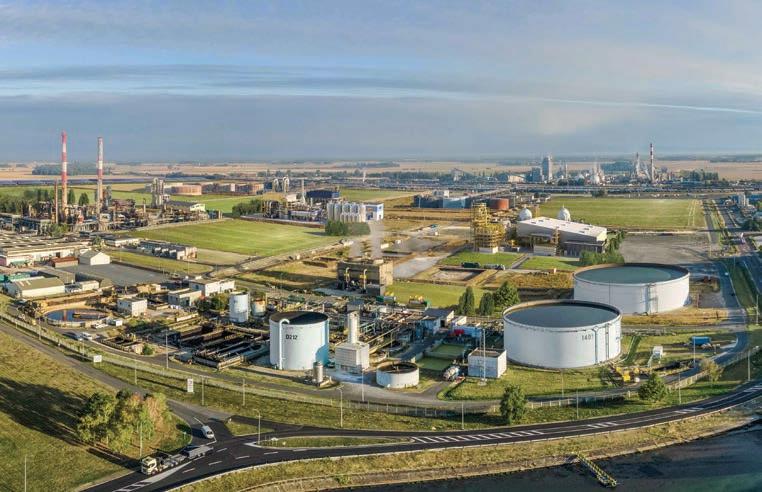
TotalEnergies paves way for a SAF future
By Kerry Lynch
TotalEnergies is ramping up production of sustainable aviation fuel (SAF) to more than half a million tonnes annually in the coming years as Europe heads toward a 6% SAF blend mandate in 2030.
To get there, TotalEnergies has built up SAF capacity at several of its refineries and recently invested €500 million into its biorefinery in Grandpuits, France, to transform the site into a zero-crude platform. As a biorefinery, the site will have a production capacity of 230,000 tonnes in 2026. TotalEnergies has teamed up with Germany-based Saria Bioindustries, which collects organic materials that will serve as the majority of the feedstock supply.
In addition, TotalEnergies’ La Méde biorefinery is on track to produce 15,000 tonnes of SAF for distribution to airports in the south of France, and its Normandy refinery has begun co-processing SAF with an annual capacity of 160,000 tonnes. Co-processing involves the treatment of both fossil jet fuel and biomass in a standard refining unit.
In Antwerp, Belgium, TotalEnergies began coprocessing 50,000 tonnes of SAF a year, but expects to expand that to 80,000 tonnes. Also on tap is a co-processing project at its Leuna refinery in Germany, with 50,000 tonnes a year planned for 2026.
These efforts come as TotalEnergies has signed a deal to deliver up to 1.5 million tonnes of SAF to Air France-KLM over 10 years. TotalEnergies also has an agreement with low-cost airline Volotea that covers SAF sales through 2029, and the company supplies SAF blends to several French airports, including Bordeaux, Toulouse, Paris-Le Bourget, Clermont-Ferrand, and Saint-Nazaire.
Looking to the future, TotalEnergies is partnered with Airbus and Safran on research, particularly for SAF blends exceeding 50%.
“TotalEnergies is taking action to meet the strong demand from the aviation industry to reduce its carbon footprint. Sustainable aviation fuels are essential to bring the air industry’s CO 2 emissions down immediately,” said TotalEnergies chairman and CEO Patrick Pouyanné. z
Falcon 2000LXSs to be made in India
Falcon business jets will be manufactured outside France for the first time ever under a partnership between Dassault Aviation and Indian company Reliance Aerostructure, announced yesterday at the Paris Air Show. Under the deal, the joint venture company— Dassault Reliance Aerospace Ltd. (DRAL)— will assemble Falcon 2000LXS twinjets at a facility in Mihar.
Falcon 2000 fuselage and wing assembly will be transferred to the Northern India plant, and plans call for the first “Made in India” business jet to roll o the line by 2028. According to Dassault, the partnership “represents a significant step in advancing India’s aerospace manufacturing capabilities, while strategically integrating into global aviation supply chain.”
Established in 2017, DRAL has been manufacturing Falcon 2000 nose sections since 2019 and has assembled more than 100 major subsections for this model thus far. Further, the DRAL facility will be designated as a center of excellence for Falcon business jets, including the Falcon 6X and 8X programs. This also marks Dassault Falcon’s first such center of excellence outside France.
“This new agreement…illustrates, once again, our firm intent to meet our ‘Make in India’ commitments, and to contribute to the recognition of India as a major partner in the global aerospace supply chain,” said Dassault Aviation chairman and CEO Éric Trappier. “It marks the ramp-up of DRAL, in line with the strategic vision shared with our partner Reliance, which led to its creation in 2017 and is a testament to our unwavering belief in our future in India and serving India.”
Reliance Group founding chairman Anil D. Ambani said the partnership is a “defining moment” for India, as well as the aviation industry and his company. DRAL said it will recruit several hundred engineers and technicians over the next decade to support its expanding operations in Mihar. C.T.
Upgrades for the Boeing CH-47 Chinook will keep the helicopter model flying into the 2060s.
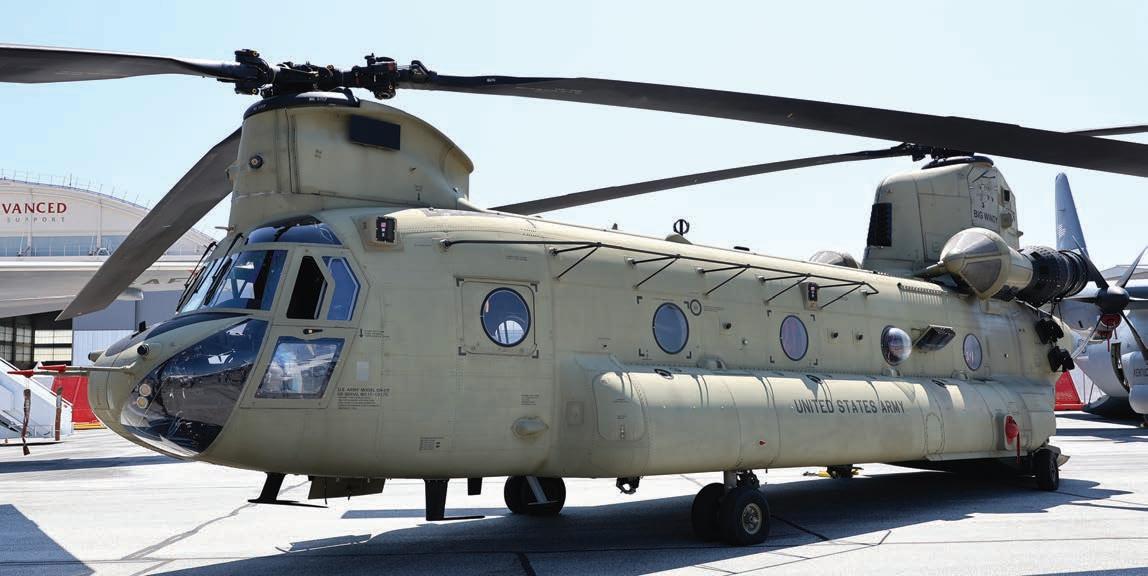
Age is just a number for Boeing helos
By David Donald
Boeing continues to work on developments for its two primary in-production military helicopters—the AH-64 Apache and CH-47 Chinook. Both types are planned to still be in service into the 2060s, and continual improvements—both in aircraft systems and mission capabilities— are necessary to achieve that goal.
Although it is likely that the AH-64D will shortly be removed from U.S. Army Aviation, force plans envision more than 600 AH-64E Apaches remaining in the active inventory, regardless of the outcome of fleet reviews. Last week, Boeing flew the version 6.5 software upgrade for the first time as part of its continual Apache improvement program.
V6.5 caters for the insertion of greater autonomy and more capability into the AH-64E’s systems, with capacity to accept more functions as they are developed or required. Greater autonomy is being introduced to reduce crew workload and to handle ever-greater data flows.
This applies to the increasing use of “launched effects” with helicopters, in which multiple
small drones can support the mission through a range of defensive and offensive effects, in addition to intelligence-gathering functions. The Apache is a natural candidate to act as a node for crewed-uncrewed teaming operations, and the V6.5 software prepares it for handling large numbers of drones and the data they generate, albeit retaining a human in the loop at all times.
Another area being studied is counter-UAS capability, and how the Apache can defend itself against small-drone attacks while keeping ground-based assets safe from large-scale UAS swarm raids.
Autonomous Elements
Autonomous elements are also being adapted to the CH-47F Block II, the latest Chinook variant, initially with the aim of improving safety and reducing workload. The active parallel actuator subsystem (APAS) interfaces with the flight control system and, among other functions, provides indications if they approach potentially dangerous areas of the flight envelope.
Pilots receive warning indications through the flying controls—akin to a “lane-assist” feature in
an automobile, reducing the need to continually monitor instruments during aggressive flying or in high-risk phases of flight. Additionally, the feature has a beneficial effect on maintenance since aircraft will cross over into high-load areas of the envelope with less frequency. APAS will also be integrated into the Apache, having already been trialed in the simulator.
Boeing’s other rotary-wing products include the MH-139A Grey Wolf, a version of the Leonardo AW139 tailored to U.S. Air Force requirements. The type is approaching initial operating capability and will be available for foreign military sales. It is also the subject of interest from other U.S. government agencies. This domestic and international interest has already led to five direct conversations, Boeing said.
In 2027, Boeing will deliver its last subassemblies for the V-22 Osprey program, which has been conducted in partnership with Bell. It is expected that the V-22 will remain in U.S. service until at least 2055 and will require upgrades and modifications. Currently, these are focused on cockpit upgrades and maintenance-related improvements. z
Honeywell Aero preps to forge its own path
By Kerry Lynch
Honeywell Aerospace Technologies is “stepping into a new era” as it prepares to emerge as a separate entity, spinning off from the giant conglomerate.
Earlier this year, the Honeywell board agreed to fully separate its automation and aerospace technologies business lines, in addition to its previous decision to spin off advanced materials. Once completed in the latter half of 2026, the result would break Honeywell into three individual publicly listed entities.
Jim Currier, president and CEO of Honeywell Aerospace Technologies, told reporters at the Paris Air Show that this year’s event is particularly meaningful. “It’s not just another airshow, but it’s a big moment for us…We are preparing to write the next chapter of our story.”
He stressed that while the business is paving the way to move forward as an individual entity, “We are not starting from scratch. We are building on a foundation of strength that’s been crafted for more than 100 years.”
While not having a formal update on the split, Currier added that he is encouraged by progress made to date. “The separation isn’t about simplifying how we’re structured, it’s about unlocking our full potential to move faster and deliver the innovations that will power the future of aerospace.”
Honeywell’s aerospace portfolio encompasses a $15 billion business in annual revenue and a global workforce of 30,000, touching nearly everything that flies in the commercial, military, space, and now advanced air mobility arenas. Honeywell Aerospace Technologies comprises three main business units: electronic solutions covering avionics and navigation; engines and power systems; and control systems.
He noted that having a balanced portfolio across types keeps down its exposure to any one market sector. For instance, half of its OEM sales and one-third of its MRO business in the commercial space come from business aviation.
“Our diversification is more than protecting against the cyclical nature of the aerospace business,” he added. “It also presents an opportunity for us to leverage technology, best practices, and other assets across a multitude of aircraft types.”
However, he noted that business right now is strong throughout, with record backlogs at aircraft OEMs reflecting more demand than supply given the doubling of commercial travel every 15 to 20 years. Business aviation has gained many users and has new platforms on the horizon. In fact, Currier told AIN that Honeywell has held discussions with OEMs on potential platforms as work progresses on the next-generation HTF7000 turbofan.
The retrofit market is taking an even greater role, he added, as existing aircraft are expected to remain in service longer but still reflect improvements in efficiency and safety. This business is growing at double-digit rates, accounting for about 10% of its sales last year.
Meanwhile, the defense business finds both the U.S. and its allies investing to meet rising geopolitical threats. Currier pointed to the 2024 acquisition of Civitanavi—an inertial navigation, georeference, and stabilization systems firm—as part of Honeywell’s overarching plans to expand its European technology and
manufacturing business in this arena.
Space, he said, remains a dynamic market with lower launch costs and an increasing number of applications that present opportunities for its sensors, communications, and navigation technologies.
“Our strategy is clear, our portfolio is strong,” Currier said. “We’re investing in our suppliers, automation, and R&D to ensure we can deliver the future of aviation.”
Working with suppliers has been particularly critical as Honeywell, along with the rest of the aerospace industry, has navigated around global shortages. He noted that the company has “heavily invested” in its base in the last couple of years.
“I feel our electronics portions of our portfolio have fully recovered,” he said. “We’ve taken large measures on the mechanical side that have gotten it to be better.”
This includes seeing 11 consecutive quarters of double-digit output growth from its factors, Currier noted, but conceded, “There’s continued room for improvement.” Anything that’s complex machining has remained difficult, he said, adding that bottlenecks tend to involve anything that requires outside specialized processing.
Honeywell is navigating this by embedding its people in supplier manufacturing plants, buying tooling, and providing capital. “We’ve invested substantially in procuring raw material for our suppliers,” he added. “We’ve been very engaged not just in our own factories and the investments that we have to do, but going down deeper into the supply base.” z
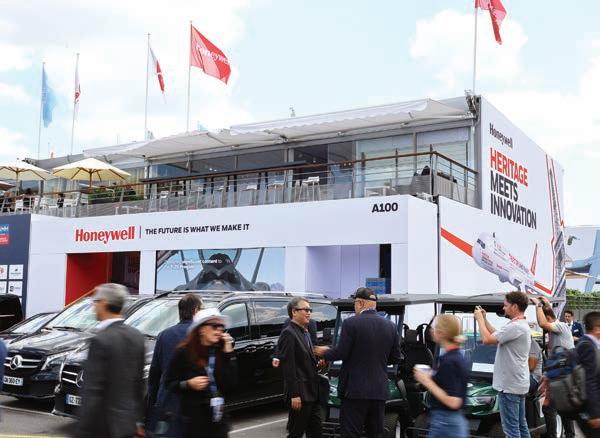
Honeywell Aerospace is preparing to spin off as a standalone company later next year. Company president and CEO Jim Currier calls it the “next chapter of our story.”
Every empty seat is a chance to save a life.

Corporate Angel Network (CAN) provides cancer patients free seats on jet and turboprop business aircraft to treatment throughout the United States.
anks to the generous support of our partners, CAN has coordinated more than 69,000 patient flights. Can you spare an empty seat or donate to our mission? e space you fill may well be in your heart.
Wisk adds early-adopt partners in Japan and Florida
By Charles Alcock
Wisk Aero has expanded its network of cities seeking to be early adopters of autonomous air taxi services using its eVTOL vehicle. On Monday at the Paris Air Show, the Boeing subsidiary signed agreements with officials from Miami and Kaga, Japan.
The partnership with Kaga also includes the JAL Engineering subsidiary of Japan

Airlines, which is already collaborating with Wisk. The city is located in Japan’s Ishikawa prefecture, which has a population of more than one million people.
Kaga o fficials and JAL Engineering will support California-based Wisk with including regulatory approval of eVTOL flights without pilots on board. They will also focus on
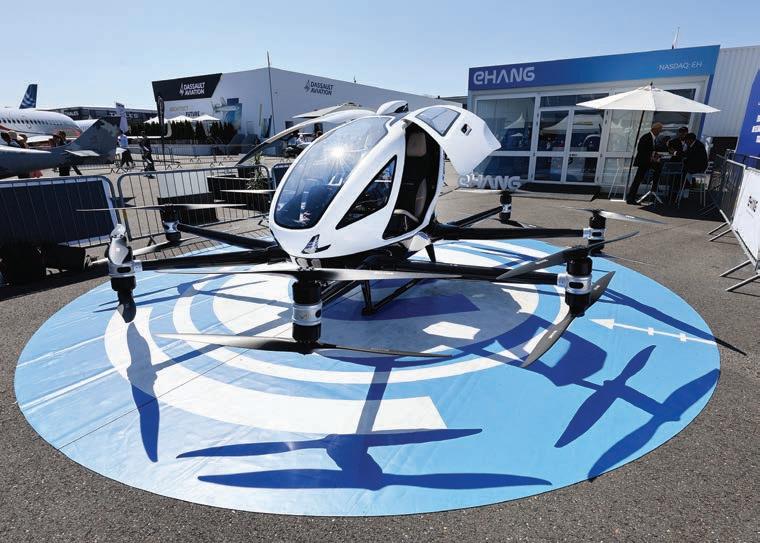
Just EHanging around…
The world’s first type certified eVTOL—eHang’s two-seat, autonomous EH-216—is making its Paris Air Show debut this week at the Le Bourget salon.
the development of supply chains and manufacturing opportunities, as well as social acceptance of advanced air mobility, market analysis, and development.
Wisk’s agreement in Florida is with the Miami-Dade Aviation Department (MDAD) and the University of Miami’s Engineering Autonomy Mobility Initiative. The university will support Wisk with research and development work on technology, regulations, and safety for advanced air mobility.
Under the memorandum of understanding with MDAD, the partners will assess locations for eVTOL operations, including possible vertiports at Miami International, Miami Executive, and Opa Locka Executive airports. Wisk will provide technical guidance on vertiport requirements for pilotless flights of its four-passenge r vehicle.
There are now five cities and regions in Wisk’s international network of partners. Previous agreements have been made with Houston, Los Angeles, and Brisbane, Australia.
Earlier this month, Wisk announced the acquisition of Houston-based SkyGrid. It said the company will support operations of its Generation 6 aircraft by providing real-time situational awareness and seamless airspace integration.
According to Wisk CEO Sebastien Vigneron, the company is almost ready to start flight testing the Generation 6 prototype. Ground testing of the prototype is nearly complete, and the company is now building a second example of the vehicle. z
CAE adds simulators in Madrid, the Philippines
By Kerry Lynch
CAE is building on its partnerships with Embraer and Cebu Pacific with the deployment of full-flight simulators (FFS) in Madrid and the Philippines.
The global training provider is placing an FFS for E2 customers at the Madrid training center near the Adolfo Suárez Madrid-Barajas Airport. The Embraer CAE Training Services (ECTS) joint venture will operate the simulators to support the growing E2 fleets in Europe, the Middle East, and Africa.
This is the second E2 simulator in the ECTS network, with the first at the CAE Singapore training center. In addition, ECTS has stationed nine Embraer Phenom business jet FFSs at CAE business aviation training facilities in Dallas, Las Vegas, Burgess Hill, São Paulo, and Vienna.
“With this new simulator in Madrid, CAE is expanding its partnership with Embraer and reinforcing its commitment to support E2 customers in EMEA,” said Michel Azar-Hmouda, CAE division president for commercial
aviation. “The advanced training offered in Madrid, featuring CAE’s competencybased training assessment courseware and CAE Simfinity virtual simulator, will enhance classroom training.”
Meanwhile, the CAE Philippines joint venture with Cebu Pacific is deploying an Airbus A330neo FFS in the Clark facility. That simulator will be ready for training by the end of 2026, joining an A320 and ATR 72-600 simulator already online at the Philippines facility.
Cebu Pacific operates 11 A330neos and is awaiting additional deliveries shortly. CAE and Cebu Pacific established their joint training center in 2011.
“Being the largest operator of the A330neo in Asia, this new simulator will provide additional training capacity and heighten the safe operation of this state-of-the-art aircraft,” said Cebu Pacific COO Javier Massot.
“This expansion will help meet the growing demand for pilot training as Cebu Pacific continues to grow its network and widebody fleet.” z
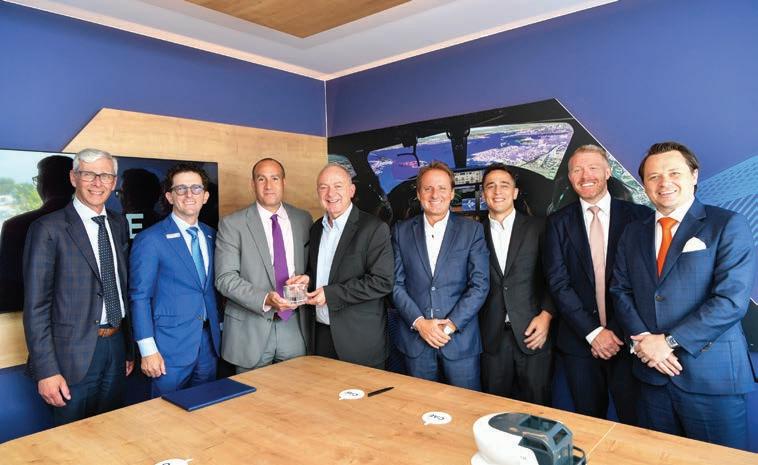
NEWS CLIPS
Textron Aviation Defense and Thai Aviation Industries agreed to jointly develop a sustainment program for the Royal Thai Air Force’s Beechcraft T-6TH trainers and AT-6TH Wolverine light attack/border patrol aircraft. The RTAF ordered 12 T-6THs for its advanced training unit at Kamphaeng Saen and eight AT-6THs to be operated by the 411 “Thunder” squadron at Chiang Mai.
Avio Aero, Safran Helicopter Engines and MTU Aero Engines have announced a new partnership to develop a high-performance powerplant that could be employed in the next generation of European military rotorcraft, including NATO’s NGRC program.
Airbus Helicopters and Leonardo are launching a joint architecture study to define the long-term evolution for the NH90 helicopter following a request from the NATO Helicopter Management Agency. The Block 2 upgrade will tackle modular avionics, improve maintenance and performance, and add new capabilities such as crewed-uncrewed teaming and collaborative combat.
Airbus and France’s Naval Group signed a framework agreement with the French armed forces minister covering procurement of the Airbus VSR700 drone. Also known as the Systèmes de Drone Aérien pour la Marine, the VSR700 is a rotary-wing UAS intended to operate on surveillance missions from French navy surface vessels.
De Havilland Aircraft of Canada received an order from the U.S. Air Force for a single Twin Otter Classic 300-G. The aircraft will be used by the Guatemalan air force on a variety of utility transport missions, the type’s characteristics suiting it to operations from short, rough strips in difficult terrain.
French defense procurement agency
DGA has selected Saab’s GlobalEye early warning and control platform. The government signed a declaration of intent with the Swedish manufacturer late yesterday to buy a pair of GlobalEye aircraft, with options for two more. The deal is expected to be finalized in the next few months and will include ground equipment training and support.
GKN Aero scales up additive production capabilities
By Sarah Rose
GKN Aerospace continues to expand additive fabrication for fan case mount rings (FCMR), aiming to reduce material waste and lead times while supporting demand for GTF engines.
“This is a turning point for aerospace manufacturing,” said GKN Aerospace president for engines Joakim Andersson. “With the FCMR program at industrial scale, we are proving not just the technical capabilities of additive fabrication, but its real-world impact on sustainability, lead time, and cost as well as bringing predictability to our supply chain,” said GKN Aerospace president for engines Joakim Andersson.
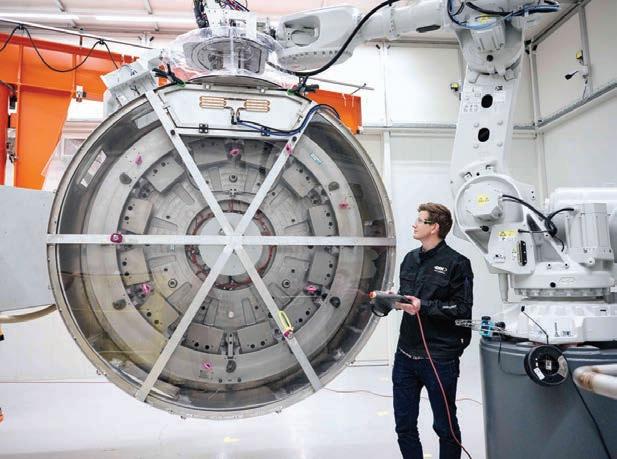
“Our recent achievements underline GKN Aerospace’s leadership in developing and certifying advanced fabrication technologies for next-generation engines—and this is just the start for this transformative technology.”
Production is underway at the company’s Trollhättan facility in Sweden, where output is expected to increase from around 30 units per month to a full rate of 40 units per month by year-end.
Earlier this year, GKN Aerospace delivered its 200th additively fabricated “hot size ring”—the core structure of the FCMR—to its
Hybrid-electric wiring harness delivers
GKN Aerospace has delivered the first high-voltage electrical wire harnesses for the Clean Aviation SWITCH program, an international collaboration exploring hybrid-electric propulsion technologies for megawatt-class aircraft.
Assembled at GKN’s facility in Papendrecht, the Netherlands, the electrical wiring interconnection systems (EWIS) have arrived at Collins Aerospace’s Electronic Controls and Motor Systems center of excellence in Solihull, UK.
Next month GKN will ship additional units to Collins’ electric power systems lab, also known as “The Grid,” in Rockford, Illinois, where it will undergo systems integration testing later this year.
Supported by the European Union through the Clean Aviation Joint Undertaking, the SWITCH project—short for “Sustainable Water Injecting Turbofan Comprising Hybrid-Electrics”—involves a consortium that also includes MTU Aero Engines, Pratt & Whitney, and Airbus, in addition to Collins and GKN. The partners are developing propulsion technologies for more e cient short- and medium-range aircraft.
“The collaboration with our consortium partners is incredibly valuable and brings deep technical insight to this groundbreaking work. Together we’re shaping the future of flight,” said John Pritchard, president of civil airframes at GKN Aerospace. K.L.
The additivefabricated fan case mount rings are a critical component for the Pratt & Wittney GTF engine powering the Airbus A220 and Embraer E195-E2.
Newington facility in the U.S. for final machining. The company plans to meet production volumes aligned with growing demand for the Pratt & Whitney GTF engine used on the Airbus A220 and Embraer 195-E2.
The FCMR is now in serial production, with additional additive activities underway for GE Aerospace. GKN Aerospace reports that current manufacturing methods result in approximately 40% less material waste per part compared to conventional approaches. Longerterm goals include achieving more than 70% material savings and reducing lead times from nine months to as little as four weeks.
In the past year, the company has reached several additive certification and manufacturing milestones. These include FAA approval for its first critical structural component made with additive fabrication, and the delivery of a large-scale titanium engine case for the CFM RISE open-fan technology demonstrator. The component was produced using fully automated direct energy deposition and met quality standards comparable to traditional casting.
The current expansion is supported by a $50 million investment made in 2024 to increase GKN Aerospace’s additive fabrication capacity. This investment is aimed at advancing the application of additive technologies across both civil and military engine programs. Starting next year, the company plans to deploy a modular production concept that could enable additive fabrication to be scaled at additional sites globally. z
Honeywell expands its license to distill (SAF)
By Kerry Lynch
Honeywell is continuing to expand its process licensing business and exploring new pathways for sustainable aviation fuels (SAF) as demand increases globally. Recently, the company partnered with St1 Nordic and Power2X as it seeks to boost production availability for SAF.
In Gothenburg, Sweden, the St1 refinery began using Honeywell’s technology to produce SAF for regional airlines, including Braathens Regional. This plant can produce up to 200,000 tonnes of renewable fuels annually using a variety of feedstocks, including used cooking oil, animal fats, and wood pulp mill waste. The biorefinery will also produce biodiesel, bio-naphtha, and bio-liquid petroleum gas.
In Rotterdam, Honeywell formed an e-fuels strategic collaboration with Power2X. Under the tie-up, Power2X will use Honeywell Universal Oil Products’ technology that combines green hydrogen and carbon to create e-methanol that can be converted to sustainable fuels.
These initiatives are among the latest in a range of projects that Honeywell has ongoing throughout its company to help the industry meet its long-term net-zero goals. In all, Honeywell has technologies in use at more than 70 facilities producing renewable fuels.
According to Willie Coetzee, Honeywell’s director of government relations for sustainable technology solutions, the company is one of the longest-standing process licensors in the world for energy technologies. He said this has been a key facilitator in the SAF refinery process.
This is part of a comprehensive suite of efforts Honeywell has explored, working in partnership on everything from electric aircraft and eVTOLs to hydrogen.
On the licensing front, Honeywell has been actively involved in various production modes. “Honeywell was one of the pioneers here,” Coetzee said.
When Honeywell first brought its eco-refining technology to market, no one was
interested, he noted. “It was the early 2000s, and we actually had to shelve it for a while because the market was just not ready,” he said. “We ultimately rolled it out and were quite successful, so we commercialized it.”
The aerospace giant has built a base through a traditional hydroprocessing technology, converting fat, oils, and greases into renewable fuels, including SAF. “But we’ve also recognized that it’s critical to be able to scale the industry and support the market. It’s critical that we enable other production pathways as well,” Coetzee said.
With that in mind, Honeywell has brought to market technologies to convert alcohols such as ethanol, as well as CO2, into SAF. It licenses those technologies to partners globally that can produce the fuels.
“We have quite a broad range of customer sets,” he said, from large integrated energy companies like Total Energies to smaller, more targeted companies.
Coetzee emphasized the importance of diversifying the fuel base. “Each feedstock has its pros and its cons, and its challenges and its opportunities,” he said, citing, for instance, that there is a limited amount of oils and greases.
Regional policy also factors in, Coetzee added. “Looking at the U.S., grown feedstocks in general is pretty accepted. In Europe, food
and feed crop feedstocks are not necessarily accepted. So there, you’re much more limited to waste oils, waste fats, those types of things.”
Ethanol-to-jet fuel is another example that may be more acceptable in the U.S. than in Europe, he added. “In the European region, CO2-to-jet is something that they prioritize a lot more greatly, so what we try to make sure as a technology company, we can enable different regions, different customers, different markets to produce the fuels in the most optimum way that suits their circumstances.”
Biomass is another up-and-coming area, according to Coetzee. Agricultural waste and forestry waste will likely become relevant globally, he said.
Despite this growth, SAF supply is still a tiny fraction of what is needed globally. However, Coetzee was encouraged about the capacity coming online. He noted that SAF production reached about 0.3% of total jet fuels consumed in 2024, amounting to about one million tonnes.
“We have facilities that operate at that scale, one single facility, and they have a space,” he said. The Power2X facility can produce 250,000 tonnes per annum alone.
“If I use those numbers of IATA, it’s a quarter of the 2024 global production at one facility, and it’s not even a big facility,” he said. “We’re getting there. What we are seeing now is a really robust project pipeline. We do believe that at least from a technology perspective and from a project pipeline perspective, we’re in quite a good space.”
More than 70 sites have licensed Honeywell technologies for renewable fuels, including sustainable aviation fuel. z

Honeywell’s technology helps to produce sustainable aviation fuel around the world.
ITP backs R&D hub to boost role as Tier 1 supplier
By Charlotte Bailey
Aircraft engines and components group ITP Aero is stepping up innovation at its new research and development center to lay the technological foundations for its growth strategy. Investments in the recently opened facility at Bilbao in northern Spain have been made with the support of its private equity majority shareholder, Bain Capital, in the three years since the company was sold by its former parent, Rolls-Royce.
The Advanced Manufacturing Aerospace Center (ADMIRE) facility is expected to boost ITP’s role as a Tier 1 supplier to multiple propulsion partners, which now also include Rolls-Royce rivals GE Aviation, Honeywell, and Pratt & Whitney. The company aspires to have more revenue-yielding intellectual property in future engine programs.
ITP is looking to build on its almost four decades of experience in propulsion technology, having been formed in 1989 to manage Spain’s participation in the Eurofighter Typhoon’s EJ200 engine. Today, the group’s involvement in the civil sector currently drives around 75% of its revenues, with last year’s 24% year-over-year revenue growth generated across its portfolio.
“No OEM can be the lead on every technology,” CEO Eva Azoulay told reporters during a briefing ahead of the Paris Air Show, explaining her intention for ITP Aero to be well-positioned with technology for the next market cycle. “We are where we are today because of decisions and programs that we got on board
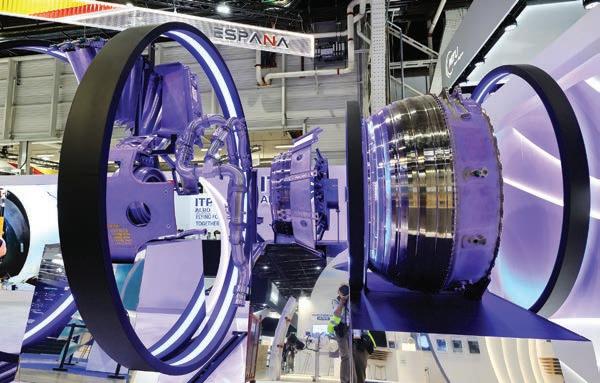
with 10 years ago. This is a long-cycle industry. If you don’t invest, you don’t get there.”
Increased R&D Commitments
ADMIRE (pronounced ad-MEE-reh in Spanish) has been established with a €24 million ($27 million) investment and builds on work undertaken at the CFAA private-public funded facility co-founded by ITP to focus on advanced machining methods. U.S.-based Bain’s commitment to research and development investment is paving the way for longer-term expansion of ITP’s portfolio, with €102 million ploughed into the business during 2024. Since being acquired from Rolls-Royce, the company has tripled its revenues and is now targeting a twofold increase in profitability by 2030.
Much of the R&D work undertaken at ADMIRE will focus on increasing the efficiency of gas turbine engines and the specialist propulsion modules produced by ITP. The 34,400sq-ft shop floor includes dedicated areas for additive manufacturing and advanced repair technologies, with a ceramics casting line to be commissioned in July.
Increased exploitation of 3D printing is seen as a key area for innovation. In August, ITP received EASA’s first certification for an additively manufactured structural component (the TP400 rear structural engine vane).
According to ITP’s chief technology officer, Erlantz Cristóbal, advanced manufacturing methods will play a fundamental role in the next-generation heat exchangers and heat management systems for tomorrow’s engines. An ITP-developed heat exchanger is also one of three modules, alongside nozzles and a
Spanish aircraft and engines group
ITP Aero is showing off its 3D printing prowess here at the Paris Air Show.
low-pressure turbine, being prepared for the Franco-German-Spanish Future Combat Air System (FCAS) program.
Another area of defense focus is the propulsion system for a potential remote carrier. However, Azoulay suggested that with such a “loyal wingman” platform potentially 15 years away from entering service, “the time spent trying to understand what is needed, what size, what capability, what scalability, is worthwhile.”
Electric Propulsion Opportunities
With evolving heat management solutions equally applicable to future propulsion technologies, ITP is also starting to explore electrification and hydrogen applications. Despite Cristóbal acknowledging that it remains unclear which of various contending power sources and architectures will emerge dominant, ITP is willing to invest in pushing the boundaries of these technologies.
This agnostic approach is exemplified by the role of another new ITP test facility currently under construction at Spain’s Morón Air Base, focusing on midsize engines of up to 35,000 pounds of thrust. This is set to be commissioned in the first quarter of 2026 and will include provision for traditional and sustainable jet fuel, alongside liquid and gaseous hydrogen.
The company conducted its first 100% hydrogen combustion test on an APU in May.
A separate project is also seeing ITP develop electric propulsion systems with power ratings ranging from 70 to 700 kilowatts for different applications. These demonstrators are to be tested over the next few weeks. z

Embraer orders
country’s vice minister of national defense. She said that the final contract could be concluded in the coming months. In addition to Brazil, other countries that also chose the C-390 include Portugal, Hungary, the Netherlands, Austria, the Czech Republic, Sweden, and Slovakia.
On the third day of the show at Le Bourget Airport, the Brazilian airframer also announced that South African carrier Airlink has agreed to lease 10 of the larger E195-E2s from Florida-based Azurra. Deliveries of the narrowbodies, which will come in a mix of 136- and 124-seat configurations, will start later this year and run through 2027.
Airlink has operated Embraer aircraft since 2001 and currently has a 68-strong fleet. According to the manufacturer, the E2, which is powered by Pratt & Whitney’s Geared Turbofan engine, will deliver fuel savings of up to 29% compared with earlier-generation E195s it operates. The carrier serves 45 destinations in 15 Southern African countries, including Madagascar, and the South Atlantic island of St. Helena.
Embraer also logged new business for its E-Freighter E-190 passenger-to-freight
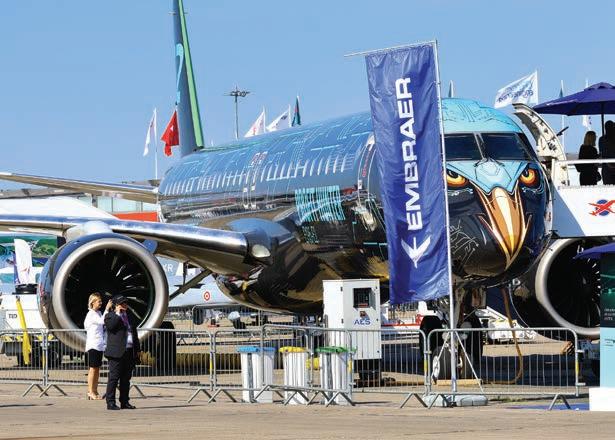
conversion program, with Bridges Air Cargo set to become the launch operator when deliveries start in the third quarter. The agreement for two of the aircraft was conducted through leasing group Regional One, which already holds two orders for the E-Freighter.
In the advanced air mobility sector, Embraer spinoff Eve Air Mobility increased its potential backlog of orders for its four-passenger E-100 eVTOL aircraft. Future Flight Global (FFG) signed a letter of intent for 54 of the vehicles as part of its plan to launch air-taxi services in key markets that will likely
ZeroAvia, Loganair explore hydrogen engines
ZeroAvia has signed a memorandum of understanding with Loganair to explore the adoption of hydrogen-electric engines for regional flights, with the goal of enabling zero-emission aviation across Scotland.
“The recent commitments made by ZeroAvia to bring their hydrogen fuel-cell manufacturing center to Glasgow and the strong engagement between our senior teams has made this next step entirely possible and logical,” said Loganair CEO Luke Farajallah.
ZeroAvia is currently working with the UK CAA to certify the ZA600, a 600-kilowatt hydrogen-electric powertrain designed for 10- to 20-seat airplanes. The Cessna Caravan is set
It was Embraer’s turn yesterday to rack up orders at the Paris Air Show. Among the highlights: a $3.6B order for up to 110 E-Jets from SkyWest.
include the Middle East and Europe.
U.S.-based FFG is working to establish a network in several locations worldwide and has previously committed to buying 116 Archer Aviation Midnight eVTOLs. It said that Eve’s connections with Brazil could help it to get established in that country.
On Wednesday, FFG announced a partnership with vertiport developer UrbanV to work on advanced air mobility infrastructure in Brazil. The companies aim to convert helipads in São Paulo into operating bases for eVTOLs and could extend these plans to Rio de Janeiro and other locations. z
to be the launch platform. Future certification plans for other airframes include the de Havilland Twin Otter, an aircraft Loganair uses to serve remote Highland and Island communities.
In addition to the ZA600, ZeroAvia is developing the ZA2000, a modular engine targeted at 40- to 80-seat regional turboprops such as the ATR family. Loganair operates more than 20 ATR turboprop twins, making it a prime candidate for future adoption of the technology.
Hydrogen-electric propulsion uses hydrogen fuel cells to generate electricity, driving electric motors with only water as a byproduct. Combined with the lower cruising altitudes of regional aircraft—which typically
do not form contrails—this results in virtually zero in-flight emissions.
Beyond environmental gains, the technology also promises operational benefits. Hydrogen-electric systems are expected to reduce maintenance costs and downtime, while hydrogen fuel itself may prove cheaper than kerosene as infrastructure scales.
The agreement with Loganair also reflects ZeroAvia’s broader footprint in Scotland, where it is partnering with Glasgow Airport and establishing a hydrogen fuel cell manufacturing facility near the airline’s base of operations.
ZeroAvia also recently announced that the UK awarded it and its partners a €10.8 million grant to develop a novel liquid hydrogen management system. S.R.
THE FUTURE IS UPON US
Our model, APCM, analyzes current and future aircraft/VTOLs, Develops operating costs and revenue margins for any mission Shows development and production costs for aircrafts/VTOLs

Data-Driven Insights

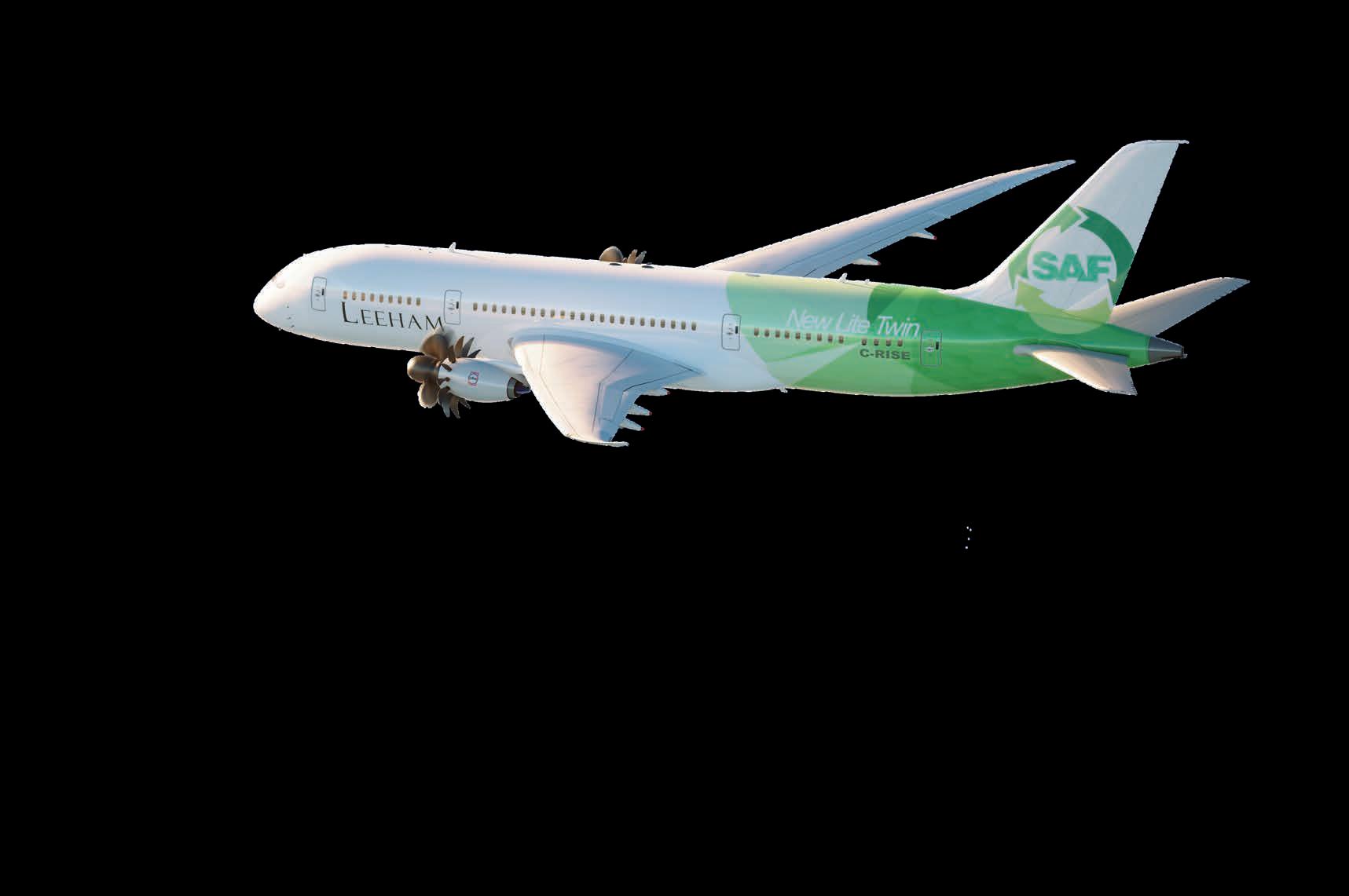
Where ‘what ifs’
